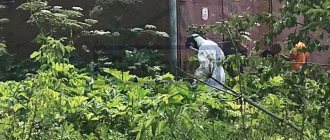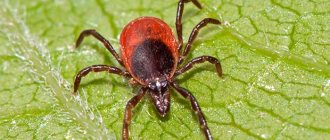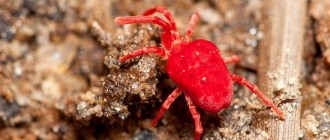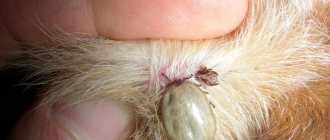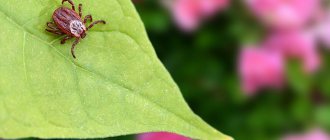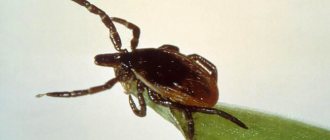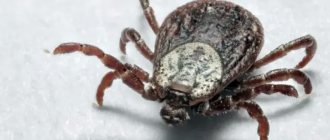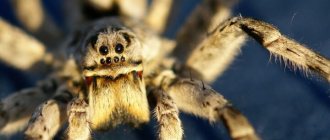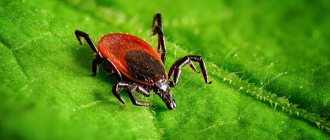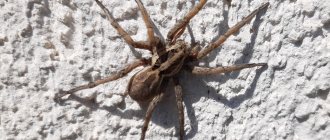Red mites are a family of mites from the order Acariformes. This is a large group of small arthropods, which got their name from the bright red integument of the larvae, the color of which intensifies when they are saturated with blood.
Red mites are characterized by a rather complex development cycle: adults and active nymphs are free-living predators that live in the soil and feed on various invertebrates, while their larvae are typical parasites that feed on the hemolymph of spiders and insects, and sometimes also on the blood of vertebrates. By the nature of their feeding, the larvae of red beetles are somewhat similar to ixodid ticks (for example, the taiga tick), and they do not have any selectivity in relation to host hosts - the larvae, during periods of their activation, are capable of en masse attacking arthropods, mammals, birds, reptiles and amphibians.
Some species are capable of attacking humans, feeding on blood and products of dissolution of integumentary tissues. The bites of such red mites are dangerous and unpleasant; they cause a special form of skin lesions (thrombidiasis). Red beetles also carry pathogens of a dangerous natural focal disease - tsutsugamushi fever.
On a note
Unlike ixodid ticks, red ticks, fortunately, do not carry tick-borne encephalitis and Lyme disease (borreliosis). However, tsutsugamushi fever is no less dangerous - if left untreated, the mortality rate reaches 40%.
We will talk further about where red mites live, what are the features of their development, nutrition and reproduction, as well as how to protect yourself from their bites...
Red tick: photo
The first and most important thing that will help you determine the type of tick found is its appearance. What does a red beetle look like?
- The body length of an adult red tick can reach 4 millimeters in length.
- The color of the tick is rich, bright, red, somewhat reminiscent of the color of a tomato.
- Everything is painted a uniform tomato color - the body, head, legs.
- The body is covered with countless fine, soft hairs, which is why the pest is often called the red velvet mite.
- Like all arachnids, the insect has 8 legs.
- Red mite larvae look like adults but are smaller, look like bright red dots, and have 6 legs instead of 8.
To finally make sure that it is a red mite in front of you, a photo of the insect will help.
Ordinary
One of the most dangerous representatives of the family, found everywhere, it is omnivorous , affecting more than 200 species of plants. Can produce up to 18 generations per year.
It is almost impossible to see on plants, since in addition to its microscopic size (up to 0.4 mm in length), it is distinguished by its inconspicuous and inconspicuous gray color.
Only towards the end of summer do females change color to reddish-red. The eggs are first greenish, then beige, pearlescent. The larvae are transparent and faded. Nymphs are colored grayish-green.
Optimal living conditions are temperature 28-30°, humidity 40-50. Damage is caused to all stages of development, except eggs.
Prevention
To prevent the disease in epidemiological regions, vaccinations against encephalitis are given to the local population, guests, and specialists staying there for work. To avoid a tick bite, follow certain rules:
- in the forest they wear clothes made of thick fabric with cuffs and drawstrings;
- be sure to wear socks and a hat;
- you need to examine the body every 2 hours, carefully after returning home;
- things are immediately thrown into the wash;
- To repel pests, repellents are used - Taiga, Off, Raptor, Raid, etc., essential oils;
- If you frequently stay in the forest, it is recommended to wear special suits with traps impregnated with insecticidal substances.
Chemicals are used to bait ticks in the forest, garden, country house, and garden plot.
Where and how do red ticks live?
Identifying red ticks can be helped not only by their very bright appearance, but also by some features of their life activity.
- Red beetles live in the top layer of soil.
- They crawl out of the ground in large numbers after rain.
- They can live in sand, black soil, forest floor, moss and loamy soils.
- Adult velvet mites do not eat constantly; they feed only once a year for just a few hours before breeding.
- The larvae eat continuously until they develop into adults.
- Ticks are active during the day, prefer soils heated by the sun, and do not appear on the surface at night.
The red beetle looks like a small bright red bug, spider or mite. Color is one of its main distinguishing features. In nature, any bright and contrasting color of insects is always a danger signal for those who may feed on them. The data available to date confirms that red beetles indeed have very few natural enemies. Scientists suggest that the problem lies in special toxins contained in the tick’s body. It is their presence that is indicated by the color of the pest.
Turkestan
Despite the name, its habitat is very extensive . This species is found in Ukraine, throughout Central Asia, in the Primorsky and Stavropol Territories, Kazakhstan, the Far and Middle East, Western Siberia, Europe and North America.
Belongs to polyphagous parasites , affecting pome and stone fruit crops, ornamental and legume plants.
The size of adult individuals reaches 0.6 mm, the color is green when feeding, overwintering ticks turn red.
The eggs are colorless at first, then yellowish-green.
The larvae are pale green, the nymphs acquire a rich green-yellow hue, and are also covered with black specks.
Arachnoid
The little red mite is a dangerous plant pest. Prefers roses, hawthorn, pear, apple, citrus fruits, seedlings, cucumbers in the greenhouse, as well as indoor flowers, especially orchids. It is problematic to notice one individual, since the maximum size of the pest is 0.5 mm. The red mite becomes noticeable when it spreads en masse through a tree, bush, or flower.
The spider mite settles on the bottom of the leaf and sucks out the juices. Gradually it affects the entire culture. Signs:
- dark, light spots on the plate;
- leaf curling, drying, dying;
- falling of flowers;
- slower growth and fruit formation;
- decrease in yield;
- the presence of cobwebs.
A humid climate, temperature within 22 degrees Celsius, promotes reproduction.
On a note!
The red spider mite has excellent adaptability. When temperatures drop, it burrows into the ground and goes into suspended animation. It can remain in this state for six months; when conditions return to normal, it resumes normal life activities.
Root mite (bulb)
It is ubiquitous. It is known to attack bulbous plants by feeding on their tissue. As a result, the flower bulb becomes a handful of dust. The “activity” of the pest can only be detected by digging the plant out of the ground .
The fertility of the bulb mite is amazing. One female lays up to three hundred eggs. Coupled with gluttony and absolute indiscriminateness in food, this insect is classified as one of the most malicious plant pests. Fortunately, there are ways to successfully combat it, otherwise it would be difficult to imagine the scale of troubles from a tick invasion.
The root mite looks like an oval enlarged on the sides. Body length – 1.5 mm. The color is faded: whitish-yellow or off-white.
How do red mites reproduce?
Like all mites, red mites are oviparous insects.
- The active breeding season can occur between March and July, the exact dates depending on local weather and general climatic conditions of the current season.
- Repeated oviposition can occur in the fall, but in the middle zone this does not happen every year.
- If the laying was done in the fall, but the larvae did not have time to complete their development, they can overwinter in the soil under the cover of snow and continue growing in the spring, after the sun warms the ground again.
- Each clutch can contain from several hundred to several thousand eggs.
- The incubation period of eggs takes from 1 to 2 months.
- After hatching, the larvae begin to parasitize insects; the stage lasts 1–2 weeks.
- After turning into an adult insect, red mites repeat the entire reproduction cycle again.
Larvae are the most voracious stage of parasite development.
Preventive measures
Prevention includes the following:
- Digging up the ground near bushes and trees in autumn and spring.
- Collecting fallen leaves.
- Planting repellent plants (onions, garlic, calendula, marigolds, etc.).
- Pruning affected bushes before cold weather.
- Burning affected leaves and stems.
Preventive measures to combat insects
How to get rid of red mite? This question should concern gardeners, as well as lovers of indoor plants, since their favorite location is the back of the leaves.
The following can be used as preventive measures:
- Several times a week, wipe the leaves of the plants with a damp cloth and spray them with chemicals to kill pests.
- When the room humidity is low, especially during cold weather, you need to regularly inspect the leaves of plants, since mite larvae love dry air.
- Monitor the condition of the soil in which the plant is located and, if necessary, spray the soil with special antiseptics.
Reasons for appearance
A spider mite attack is an unpredictable thing. The pest can appear in the most unexpected places: for example, on barely planted seedlings of tomatoes or cucumbers, or on your favorite lemon tree, which has been growing in the apartment for many years.
Microscopic pests and eggs spread through:
- Free-ranging animals;
- When there are gusts of wind;
- Human;
- Contaminated soil;
- Infected planting material (seeds, shoots, cuttings).
The pest overwinters in fallen leaves and soil.
Over the course of a year, from 10 to 20 generations can grow in an apartment, from 10 to 15 in a heated greenhouse, and 3-4 generations in a greenhouse without heating or on the street. Spider mites pierce leaves and stems, feed on plant sap and are absolutely unpretentious in food. It settles on indoor plants, weeds, vegetables, tops of root crops, shrubs and trees. The pest, which itself is a carrier of diseases, can introduce viral and fungal infections, mainly gray rot, into the puncture sites.
Red tick: is it dangerous?
Many justifiably associate ticks with blood-sucking parasites, although in nature there are a colossal number of species that do not consider humans or other warm-blooded creatures as a source of food. How does the red tick behave in this regard and is it dangerous?
As is the case with other ticks, the degree of danger of red mites is entirely based on their diet.
- Red mites feed mainly on insects smaller than themselves, their eggs and larvae.
- Cannibalism is common among red beetles.
- The larvae of velvet mites are especially voracious; in a day they absorb twice as much food, and sometimes three times as much as an adult insect.
- Ticks feed on body fluids and tissues, not specifically blood, although physiologically they can absorb and digest it.
Thus, red mites are not blood-sucking parasites, but they are carnivores, which means they have a predisposition to feed on living organisms. Is it dangerous for humans and pets?
Damage caused by scale insects
All mealybugs feed on the sap of plant cells. By piercing the leaves with their sucking mouth, like a needle, they take away the plant liquid (juices):
- As a result, plants lose their tone and change color.
- The leaves turn yellow and fall off.
- Photosynthesis occurs slowly.
This makes the plant susceptible to diseases and infections.
Important! As a result, the plant dies. And the tick itself becomes a carrier of infections (viral diseases, gray rot).
Why is it considered a pest?
The spider bug is very polyphagous; from one infected flower or plant it can infect all the others. It spreads readily and in large quantities at home, in greenhouses and greenhouses, and on plants growing in open ground. If you do not apply control measures, you can easily be left without a harvest: berries, vegetables and even fruits.
Signs of infection
This parasite has a red butt on the underside of the leaves, but it cannot be seen due to its very small size. Also, we will not be able to examine the damage that appears on the leaves after a bite. But the consequences of its presence on the flower have obvious signs.
Proof of its presence are small brown spots on the leaves. When their colony is large enough, a few spots are not enough; large affected areas and spots appear. These are the consequences of the bites, but as the juice is sucked out of the leaf, its yellowing is noticeable, the plant weakens and, as a result, the leaves fall off.
Another telltale sign is the presence of cobwebs. It envelops the space between the stem and leaf. The more insects there are, the more webs, large populations, are able to completely envelop the flower.
Conclusion
Having drawn a line above the above, it becomes clear that in order to prevent the appearance of the creature, it is enough to carry out timely prevention, which brings enormous benefits.
It is recommended to remember what a spider mite looks like and how it can be identified by its foliage symptoms. If you watch the video on how to deal with them, you can summarize that a lot depends on the species.
Some surrender quickly, without resisting, while others stand to the last. If the bush becomes infected, then you need to urgently take measures to save it, you cannot hesitate. We wish you good luck during the rescue procedures!
Why is the red tick dangerous for humans?
According to official scientific data, the red tick is not dangerous to humans. We are talking specifically about ordinary red mites, and not about all representatives of acariform mites or red mites. People and domestic animals are not the mainstay of the common red beetle's diet; the tick does not depend on them for food, and accordingly, there are no official statistics on common red beetle bites. However, hypothetically, as an exception, since there is no official data on this matter, red beetles and especially their larvae, due to indiscriminateness, can bite a person, although the likelihood of this event is negligible. In this case, you will receive maximum skin irritation and a fleeting local allergic reaction, and the bite site will heal in a matter of days. If a tick of a shade close to red has attached itself to the skin, most likely it is some kind of tick from the ixodid family
.
Development timeframe
The duration of the life cycle depends on the ambient temperature. At 20°, the tick goes through all stages of development in 20 days, at 25° - in 10-12 days, at 30-32° - in 5-6 days.
How long does an adult spider mite live? Under favorable climatic conditions, without falling into diapause, an adult individual exists from 16 to 30 days .
Where does the parasite spend the winter? When the temperature drops below 18°, spider mites enter diapause , having previously found a quiet, secluded refuge.
It can be:
- Plant residues - tops of cultivated plants, weeds.
- The top layer of soil - the tick can hide to a depth of 20 cm.
- Bee hives.
- Parts of greenhouse structures.
- Fences and storage boxes.
Reproduction of red beetles
Formed red mites are characterized by weakly expressed sexual dimorphism. This type of mite is distinguished by a very complex form of metamorphosis. It was the result of the fact that some phases of development perform the function of nutrition, while others completely cease to feed. They have turned into a kind of formative resting phases and in this way resemble an insect pupa.
Unlike insects, which have a single pupa, red beetles are characterized by an alternation of morphogenesis and feeding phases. Eggs that are laid in the soil layer hatch into a motionless prelarval form. Then, consuming the yolk reserve from the intestines, it turns into a larva.
Red mites are characterized by similarity in the external genitalia of both sexes. Spermatophore fertilization without copulation was preserved. The reproductive apparatus is equipped with a lid, a protruding cone, and three pairs of genital tentacles.
Red tick in dogs
Dogs, just like people, are not food for red ticks. Insects do not specifically attack them and do not stick to them in large numbers, so red ticks in dogs are mostly a myth. At the same time, insects may end up in a dog’s fur simply because the dog was lying on the ground, and the larvae may try to bite because they cannot discern whether the food in front of them is suitable or not. Such bites are not dangerous to animals and are unlikely.
If you find red ticks attached to your dog, in the vast majority of cases these are one of the types of blood-sucking ticks. Tick bites are extremely dangerous for dogs, mainly due to tick-borne encephalitis, so as soon as you discover a parasite on your pet or notice any alarming symptoms in his behavior or appearance, contact your veterinarian immediately. This must be done even if you pulled out the tick yourself. Author of the article Myagkov Sergey
What plants does the pest attack?
Among vegetables, spider mites often attack cucumbers, tomatoes, eggplants, peppers, legumes, and pumpkin crops .
Strawberries, gooseberries, currants, raspberries, and grapes are damaged by insects .
Spider mites harm fruit trees: apple trees, pears, apricots, cherries, plums, cherry plums .
The parasite loves flowers and ornamental plants: roses, asters, palm trees, fuchsias, callas, citrus fruits, orchids, impatiens, abutilons, ficuses, saintpaulias, cyclamen, pelargoniums, azaleas .
Destruction methods
There are many ways to combat the red flat mite and here are some of them.
Non-chemical methods
An abundance of host plants, a warm, humid climate and few natural enemies provide favorable conditions for high population densities of this mite. Therefore, creating conditions contrary to this does not support active reproduction of the pest. The best option for combating red mites, which is accepted in greenhouse conditions, is to lower the temperature as much as possible so that it does not harm the plants and is not economically expensive.
Biological control
At least four predators of the red flat mite are known. These include three larger ticks and one beetle:
- Phytoseiulus macropilis.
- Amblyseius largoensis (Muma).
- Mexecheles hawaiiensis (Baker).
- Sticholotis beetle.
Predatory mites, P. macropilis and A. largoensis feed on red mite eggs but do not attack other life stages of the pest. Larvae, nymphs and adults of M. hawaiiensis attack all active stages of the red flat mite. As for the sticholothis beetle, it is used to control the scale of the red mite in China and Japan, where the pest is also very numerous. The bug loves to feast on all stages of the pest, and it does absolutely no harm to plants.
The predators mentioned above generally do not provide economic control, since their predation only becomes apparent when the prey population density is very high. Therefore, this type of struggle is relevant only on an industrial scale.
Sticholotis beetle - enemy of red mites
Chemical control
Because this mite reproduces parthenogenetically, like most other false spider mites, they do not have the genetic variation that occurs when mixing with most species of mites that reproduce sexually. Thus, pesticide resistance is less likely and less of a problem. Despite this, the red flat mite is resistant to certain organophosphates and is susceptible to most acaricides. In addition, resistance may develop if pesticide use has been very frequent.
Chemical sprays should be applied to affected plants at 2-3 week intervals if the infestation is severe. Any of the registered acaricides is usually effective. But sulfur should not be used in places where the relative humidity is abnormally low.
How to get rid of it: control measures
When the first signs of the presence of a mite on an orchid are detected, it is necessary to begin eliminating it without delay, since ignoring this problem will lead to the death of the affected plant and massive infection of other indoor crops.
Procedure:
- isolation of the affected specimen in a separate room;
- rinsing under running warm water;
- removing moisture from the sinuses and drying the plant.
If the white coating cannot be washed off with water, it is recommended to wipe the leaf blades with cotton swabs or pads soaked in water. To increase humidity, it is recommended to water the epiphyte, wrap it in plastic wrap and leave it in this form for no more than three days.
If oribatid mites are detected, several manipulations must be performed:
- remove the plant from the pot and clean it from the soil;
- dilute liquid laundry soap (1 tbsp/1 l) in warm water;
- soak the root system in the prepared solution and leave for 30 minutes, periodically shaking off mite eggs from the roots;
- repeat the soaking procedure 2-3 times, replacing the solution with a fresh one;
- remove damaged fragments;
- treat cut areas with activated carbon;
- plant the flower in clean soil.
After providing first aid to the orchid, it is necessary to begin its radical treatment.
Treatment
Birch tar is used to treat chicken acariform mites on the legs of poultry. It is heated to a temperature of 40 degrees, poured into a deep bath and the chicken is placed in the solution up to the hock joint. You can simply treat the parasite-affected surface of the leg with tar, using a soft brush, at intervals of 6–7 days.
Advice! If the mite lives on the legs of chickens, use a solution of Trichlorometaphos or a mixture of birch tar and kerosene in a 1:1 ratio.
If chickens are infected with scabies mites that live on their legs, the parasites can be removed using acaricidal-insecticidal agents of complex action in drops, solutions, and aerosols. They are simply rubbed into the affected skin several times at intervals of 2-3 days.
Clover mite (Bryobia praetiosa)
It is brown or green in color. up to 0.6 mm long. Lays spherical dark red eggs on the leaves. It affects ambucilon, Japanese euonymus, ficus and peperomia. A soap solution helps a lot in the fight against bryobia. Root mites damage underground parts of plants. They actively reproduce and develop in a wide temperature range, 10-25 degrees and above.
They multiply especially quickly at high air humidity. Therefore, to prevent the appearance of root mites, store bulb tubers and root vegetables in a cool, dry room, with a humidity of at least 60%. Bulbous plants are primarily affected: amaryllis, hipeastrum, hyacinth, gladiolus, tulip, orchids. In the affected parts of the plant, passages filled with brown dust are visible.
Let's sum it up
In some cases, the mite can cause mass mortality of poultry, so farmers, regardless of the method of keeping chickens, should not exclude this possibility. It is better to carry out preventive treatment first and protect individuals from parasites.
Video - Process of treating chickens for parasites
Nikolay Zhuravlev chief editor
Author of publication November 22, 2018
Did you like the article? Save so you don't lose!
Chicken mites cause a lot of problems not only for the birds themselves, but also for farmers and poultry farmers. In the event of infection with a dangerous ectoparasite, laying hens' productivity decreases and the condition of their feathers deteriorates. Chickens and young broiler breeds infested with feather mites lag behind in growth and development compared to their healthy peers and slowly gain weight. Despite the fact that parasitic mites are most active in the warm season, birds can become infected in any season. How dangerous are chicken mites? How to fight and completely get rid of chicken mites?
Features of character and lifestyle
Photo: Spider mites in the garden
Despite their almost microscopic size, spider mites are truly dangerous pests of both wild and cultivated plants. In a short time they can harm not only home collections of plants, but also large nurseries that are engaged in the industrial cultivation of flowers. Juvenile ticks have three pairs of legs. After two molts, they acquire another pair and become adults - adults. Females live on average from 5 to 40 days.
The most comfortable temperature for the life and development of spider mites is from plus 25-30°C. At this time, their complete development (from egg to adult) takes 7-8 days. When the temperature drops, the development process occurs in 28-32 days. Spider mites typically live on the underside of leaves. There he makes many small holes and sucks out the juice.
Leaves damaged in this way become dehydrated, wither and dry out. Even a minor infestation by these pests can significantly affect the development of a plant. Indeed, with a prolonged attack by mites, the plant’s ability to photosynthesize decreases significantly. And without this important process, plants weaken and may even die.
When daylight hours decrease to 14 hours, only overwintering female pests can develop. Thanks to diapause, they can easily tolerate temperatures dropping to minus 28°C. In spring, when the air temperature rises to plus 12-14°C, female mites wake up, crawl out of the soil and settle on the back of plant leaves, abundantly entwining them with cobwebs.
They also lay eggs here, since they left for the winter already fertilized. The very first thing is that the spring offspring of spider mites develop on quinoa, nettle, and plantain. By mid-July, arthropods gradually move onto cultivated plants.
Why does a spider crawl in bed, on a bed, on a pillow: a sign
- On the hand - a generally positive sign.
- On the left hand - to wasteful spending.
- On the right hand - extra money will appear.
- Crawling along your arm or shoulder - soon you will meet an old acquaintance or receive a message from him.
- Sat on your hand - also a positive meaning.
- Crawling up your hand - your loved ones or friends want something from you.
- On your face - something good awaits you in the near future.
- Came down from the ceiling in front of your face - a positive sign. Your business portends success for you, you will be prosperous.
- Slowly spinning a web in front of your face is also positive.
- On your feet - to new acquisitions.
- Crawling up the leg - to large purchases.
- Crawling over a person’s body - to monetary rewards.
- Why is he running all over me? Perhaps they will give you a bonus.
- Sits on the body - soon there will be financial well-being if you don’t give up.
- On the neck - perhaps your loved ones will help or please you with something.
- On your hair - expect guests. Hair is associated with cobwebs, so the sign is favorable.
- Crawling up clothes - you will buy yourself new clothes or personal items.
- On shoes - you will have to lose something or spend a lot of money.
- In a circle - you have an envious person.
- A spider crawls up your body - the business you are doing will bring you success, harmony and prosperity.
- A spider is crawling down your body - most likely, you will soon experience minor financial difficulties.
- A spider crawls along your right hand - a good job with sufficient income will come your way.
- A spider crawls along your left hand - do not lend money, it may not come back to you.
- A spider crawls along your right leg - a person you will meet soon can give you wealth and prosperity.
- A spider crawls along your left leg - due to quarrels and damaged relationships with loved ones, you risk losing your income.
- A spider crawls across your chest - your health is not in the best condition.
- A spider crawling on your head - a sign foretells pleasant changes for you in the near future, perhaps a meeting with a good person or news.
- A spider crawls along your right shoulder - you risk doing the wrong thing.
- A spider crawls along your left shoulder - extra spending can ruin you.
Spider and signs associated with it
Signs and interpretation:
- The spider crawls across the floor to the left - do not borrow money from anyone in the near future, it may not come back to you.
- A spider crawls across the floor to the right - most likely, your debt will soon be returned or someone will be able to help you financially.
- A spider crawling across the floor towards you means pleasant changes in life, good news.
- A spider crawls across the floor away from you - protect yourself from waste and communication with unpleasant people.
- A spider crawling along the ceiling to the right is a good omen, you will be in abundance, your expenses will not ruin you. The profit will be much greater.
- A spider crawls along the ceiling to the left - a sign that your financial situation will be quite good, but you should still protect yourself from unnecessary waste.
- A spider descending from the ceiling is a bad omen, foreshadowing a financial “hole”: debts, loans, ruin.
- A spider on the wall is a good omen, which tells you that your financial situation will improve in the near future.
- A spider crawling down the wall portends spending, wasting money, problems with debts and losses in gambling.
- A spider crawling along the wall to the right means that you will be able to get good benefits from odd jobs.
- A spider crawls along the wall to the left - a little financial help from loved ones.
Correct interpretation of signs with spiders
- A spider descended on your head - a favorable meeting with a good person, prosperity and well-being.
- A spider descended on your hand - soon you will be lucky enough to find a source of additional income.
- A spider descended on your hair - you will receive good news or you will meet a significant person.
- A spider has descended on your face (nose, eye, mouth) - take care of yourself from diseases, “bad” people with the “evil eye”.
- A spider descended in front of your face is a good omen that portends many pleasant events in your life.
- A spider on the bed means betrayal by one of the spouses or possible deception on the part of a loved one.
- A spider on the wall near the bed means that one of the spouses has a rival.
- A spider crawled out from under the bed - deception and betrayal of one of the spouses, a loved one.
- Spider on the pillow - male infidelity
- A spider on the ceiling above the bed - quarrels, problems and scandals caused by the betrayal of spouses.
The spider and the signs it brings
Harm to plants
Where does it come from on plants? Quite a logical question! How do spider mites get into houses, greenhouses, outdoor front gardens and beds? There are many ways of entry.
It can be brought into homes with newly acquired plants purchased to replenish the collection.
Therefore, it is recommended to first keep all new specimens in quarantine.
In addition, ticks can be brought into apartments and other enclosed spaces on clothing or accessories, such as bags and umbrellas.
They can be on bouquets of flowers. And it can easily be carried by the wind . In open areas, the mite may appear, carried by air flow, with seedlings or seedlings purchased at the market or in a store.
Where can it be found? This pest is capable of attacking most existing plants . It settles in the garden, in flower beds, on vegetable crops and fruit bushes, and can attack indoor flowers. Of course, he has his own preferences. What plants does it affect?
Indoor flowers
Spider mites do not really like pubescent leaves , so they practically never occur on violets (Saintpaulias), gloxinias, kolerias and calceolarias.
Moreover, some gardeners try to get rid of the pest by placing Saintpaulias near the affected flowers. These vegetarians also cannot tolerate aloe and never grow on it. But ticks just love:
- ficus;
- fuchsia;
- palm trees;
- callas;
- azaleas;
- shefler;
- balsams;
- abutilone;
- ivies;
- sicndapsus;
- syngonium.
However, do not think that the mite will bypass other plants! Almost all flowers can be attacked . Find out more in the article “How to deal with spider mites on indoor plants at home?”
Outdoor plants
It’s easier to say what spider mites don’t like, because the list of their preferences is almost impossible to describe. The pest will never settle on:
- calendula (marigold);
- marigolds;
- dandelions;
- cyclomene.
Moreover, ticks can be repelled from plants by planting these flowers between them. After all, these pests cannot stand their smell at all . Details in the article “Spider mites: treatment of roses, apple trees, marijuana and other plants.”
Fruit crops
Only the elderberry can be saved. Mites really love , especially strawberries and wild strawberries. “The fight against spider mites on berries” is described in detail in the article on our website.
Garden vegetables
In the affected crops, there is not a single variety of onion, and even garlic . In addition, these plants are often used against mites, as described in detail in the article “Fighting spider mites on vegetables.” But cucumbers, eggplants, and peppers are the favorites of gourmet ticks.
In the article “Fighting spider mites on cucumbers” you will learn how to effectively destroy the pest and prevent it from appearing again.
Medicinal herbs and spices
There are relatively few food plants for ticks here. Mint and lemon balm are at greatest risk . But many herbs help get rid of the pest.
It will never settle on chamomile, mustard, parsley, basil, tansy, celandine, yarrow and all types of wormwood.
In addition to these plants, spider mites can be found on different varieties of grapes, legumes and grain crops, and forest plants, including trees. According to scientific classification, spider mites are polyphagous pests .
Types of flat beetles
There are many types of spider mites, but the most common are:
- Regular - size may vary depending on its fatness. Color - from orange to bright red. Damages about two hundred species of plants.
- Red spider - sizes can vary from one tenth of a millimeter to 2 mm. Color – all shades of red. Damages plants indoors.
- Red-legged spider - threatens many ornamental plants. The body is most often orange.
- Atlantic spider - widespread everywhere. It primarily damages cucumbers.
Biological agents
The advantage of biological agents is the ability to treat plants throughout the year and the inability to induce resistance in parasites. The disadvantage is that it is effective only at the initial stage of the lesion. The most common biological agents:
- Bona Forte - created on the basis of Dalmatian chamomile flowers. Allows you to get excellent results in the fight against all types of ticks.
- Akarin - contains the active ingredient avertin N, available in ampoules. Before use, dilute with water: 1 ml/1 liter.
- Fitoverm - available in the form of a concentrated suspension, contains the biopesticide aversectin C. Maintains a protective effect for 2 weeks from the date of treatment.
Most likely routes of spread
The pest has one peculiarity - it is practically impossible to infect plants from the street with it, since it cannot stay outside its place of residence for a long time. Healthy plants become infected only from sick relatives through their introduction. Since the bite is completely invisible, this becomes the main reason for the proliferation of red mites. That is why each new plant should be carefully examined using magnifying devices.
Mites suck out quite a lot of leaf cells, which leads to a decrease in the process of photosynthesis. The plant weakens greatly and becomes easy prey for many diseases and other pests. This means that the death of plants does not occur as a result of direct small bites, but rather from their consequences, since they provoke an outbreak of other diseases that are more dangerous for the flora.
Use in folk medicine
The hemolymph of the red mite has a fairly powerful fungicidal effect. In this regard, it is widely used in folk medicine of the people of India. It is used to prevent paralysis, and also as an aphrodisiac: it is believed that the oil obtained from red beetles increases sexual desire. In modern medicine, this issue is still at the stage of consideration. Scientists are just looking at these arthropods as a potential source of immunomodulators.
Source
